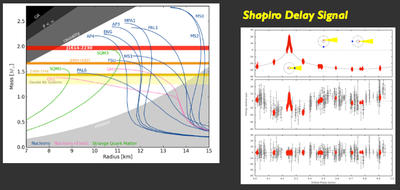The Massive Pulsar PSR J1614-2230: Linking Quantum Chromodynamics, Gamma-ray Bursts, and Gravitational Wave Astronomy
Investigators: Feryal Ozel (1), Dimitrios Psaltis (1), Scott Ransom (2), Paul Demorest (2), Mark Alford (3)
(1) Univ Arizona, (2) NRAO, (3) Washington Univ.
 The recent measurement of the Shapiro delay in the radio pulsar PSR J1614-2230 yielded a mass of 1.97 +/- 0.04 M_sun, making it the most massive pulsar known to date. Its mass is high enough that, even without an accompanying measurement of the stellar radius, it has a strong impact on our understanding of nuclear matter, gamma-ray bursts, and the generation of gravitational waves from coalescing neutron stars. This single high mass value indicates that a transition to quark matter in neutron-star cores can occur at densities comparable to the nuclear saturation density only if the quarks are strongly interacting and are color superconducting. We further show that a high maximum neutron-star mass is required if short duration gamma-ray bursts are powered by coalescing neutron stars and, therefore, this mechanism becomes viable in the light of the recent measurement. Finally, we argue that the low-frequency (<= 500 Hz) gravitational waves emitted during the final stages of neutron-star coalescence encode the properties of the equation of state because neutron stars consistent with this measurement cannot be centrally condensed. This will facilitate the measurement of the neutron star equation of state with Advanced LIGO/Virgo.
The recent measurement of the Shapiro delay in the radio pulsar PSR J1614-2230 yielded a mass of 1.97 +/- 0.04 M_sun, making it the most massive pulsar known to date. Its mass is high enough that, even without an accompanying measurement of the stellar radius, it has a strong impact on our understanding of nuclear matter, gamma-ray bursts, and the generation of gravitational waves from coalescing neutron stars. This single high mass value indicates that a transition to quark matter in neutron-star cores can occur at densities comparable to the nuclear saturation density only if the quarks are strongly interacting and are color superconducting. We further show that a high maximum neutron-star mass is required if short duration gamma-ray bursts are powered by coalescing neutron stars and, therefore, this mechanism becomes viable in the light of the recent measurement. Finally, we argue that the low-frequency (<= 500 Hz) gravitational waves emitted during the final stages of neutron-star coalescence encode the properties of the equation of state because neutron stars consistent with this measurement cannot be centrally condensed. This will facilitate the measurement of the neutron star equation of state with Advanced LIGO/Virgo.
Publication: Accepted for ApJ Letters. arXiv: 1010.5790V1 (10 Nov 2010)




Connect with NRAO